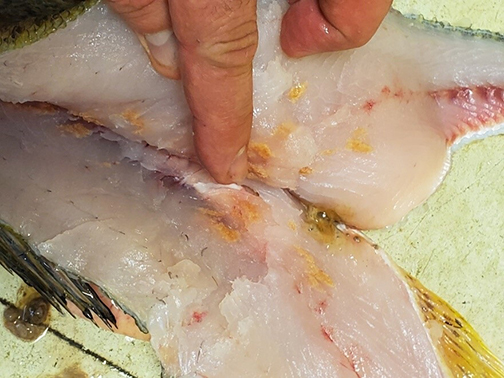JEFFERSON CITY, Mo. – Due to a recent finding of Sandy Flesh disease in walleye taken from Bull Shoals Lake in Arkansas, Missouri Department of Conservation (MDC) biologists are asking Missouri anglers to watch for this uncommon fish disease.

Characteristics of Sandy Flesh disease include tough, granular, coarse, and yellowish-brown muscle tissue with knotted muscle fibers. Pictured is infected walleye from Missouri’s only confirmed report of Sandy Flesh disease in 2019 at Table Rock Lake.
The most recent discovery of Sandy Flesh disease occurred in a walleye harvested in September by spear-fishing anglers in Bull Shoals in Arkansas near the Arkansas-Missouri border. The only confirmed report of Sandy Flesh disease in Missouri was in 2019 at Table Rock Lake. However, the proximity of this recent discovery to Missouri has prompted MDC fisheries biologists to ask Show-Me State anglers to be on the lookout for this disease.
“Because of the recent case in Bull Shoals, which spans two states and has connectivity to a number of streams and other reservoirs, it makes sense to ask anglers to look for this disease in Missouri, too,” said MDC Sport Fish Ecologist Robert Weber. “Though we’re still learning more about this uncommon disease, angler reporting of potential cases of Sandy Flesh disease will keep us better informed and help track its prevalence.”
Sandy Flesh disease is a degenerative muscle disease that has been present in the upper Midwest region of the U.S. for a number of years. It should be noted that, though this disease has been found in several states, it is uncommon – where it has been found, it seems to impact only a small number of mature walleye. It has also been found in yellow perch, but it appears to be a disease that primarily affects mature walleye. The disease is believed to be non-transmissible to humans though MDC never recommends consumption of any meat from diseased fish or wildlife. Specifics about the cause and mode of transmission of Sandy Flesh disease are still unknown, but the disease doesn’t appear to be transmissible to other fish species. The emergence of the disease is thought to result from a combination of genetic factors and environmental stressors.
There are no external signs of Sandy Flesh disease on an infected fish; it is only visible once the fish has been cleaned and filleted. The affected tissue resembles freezer-burnt meat. Characteristics of the diseased flesh include tough, granular, coarse, and yellowish-brown muscle tissue with knotted muscle fibers.
Anglers can help biologists gather information about this disease by reporting potential cases to local MDC fisheries biologists. Photographs of discolored filets and any other information about the fish are helpful. MDC staff may be interested in collecting samples for testing if fish are reported promptly.
Anglers should not dispose of infected fish in the body of water where they were caught or in other reservoirs or streams. Infected fish should be disposed of by burying the carcass or placing the remains in trash bags for disposal through trash collection.
More information about this disease can be found at https://mdc.mo.gov/fishing/fish-diseases/sandy-flesh.
